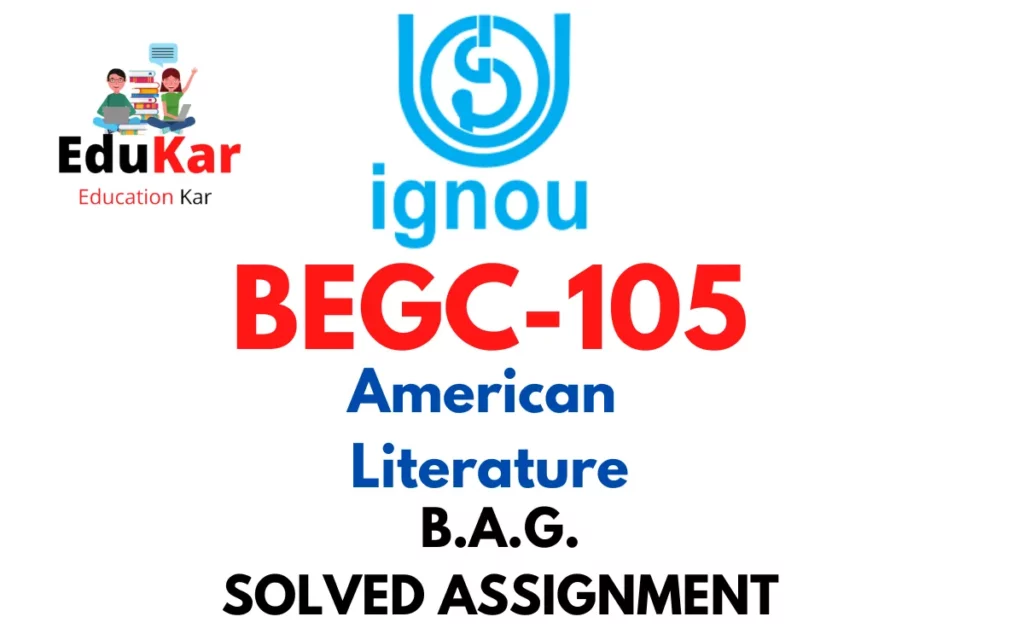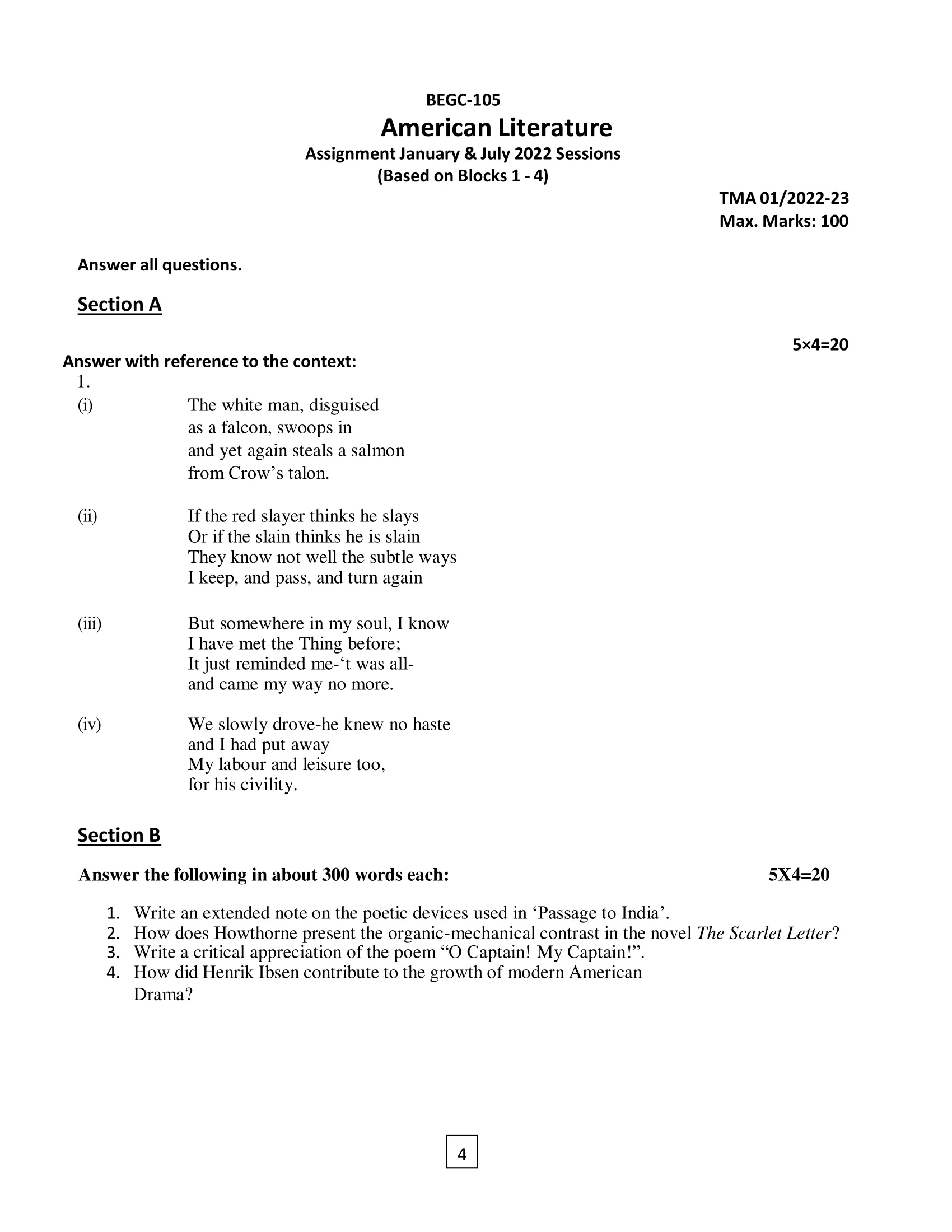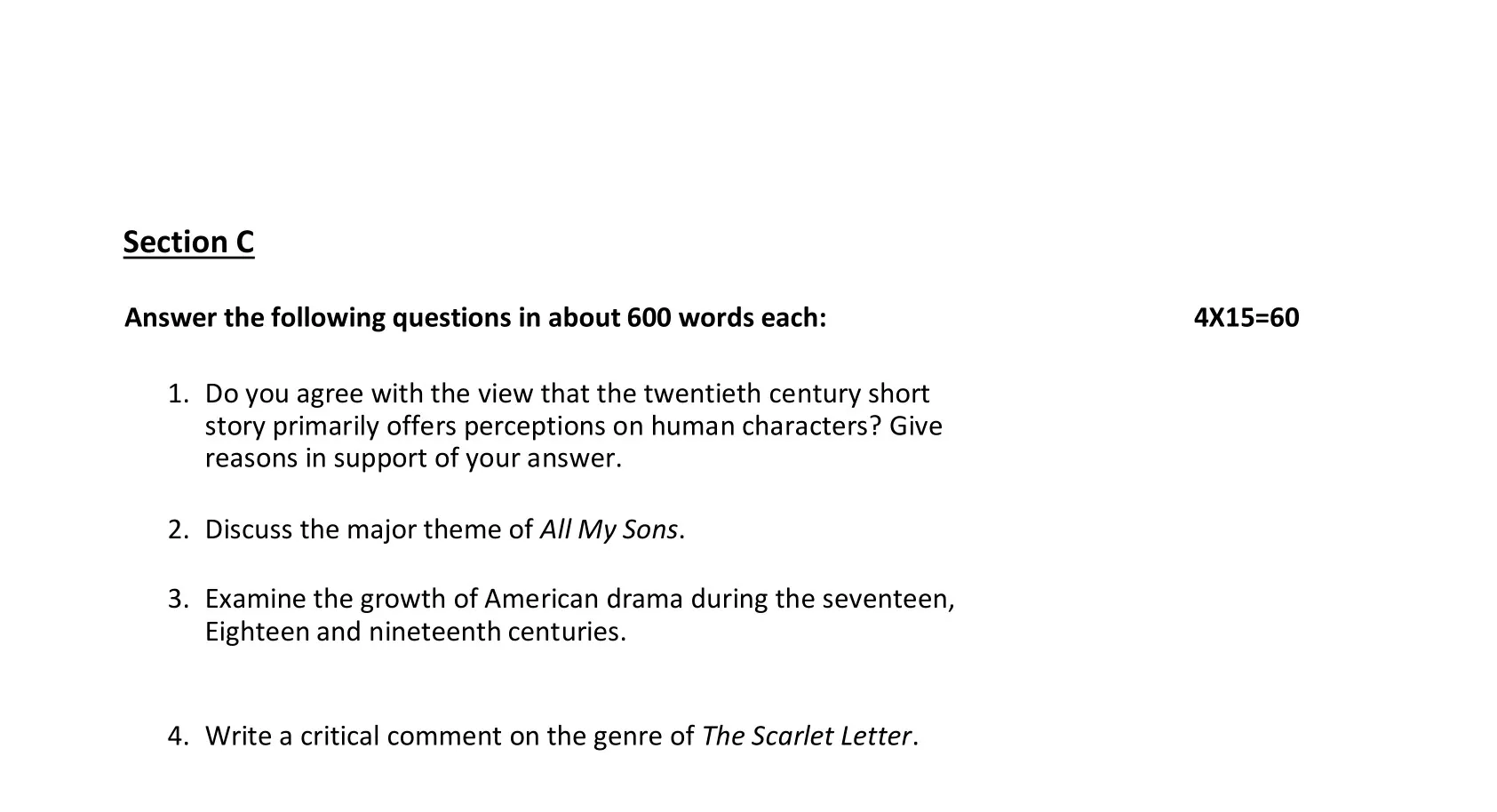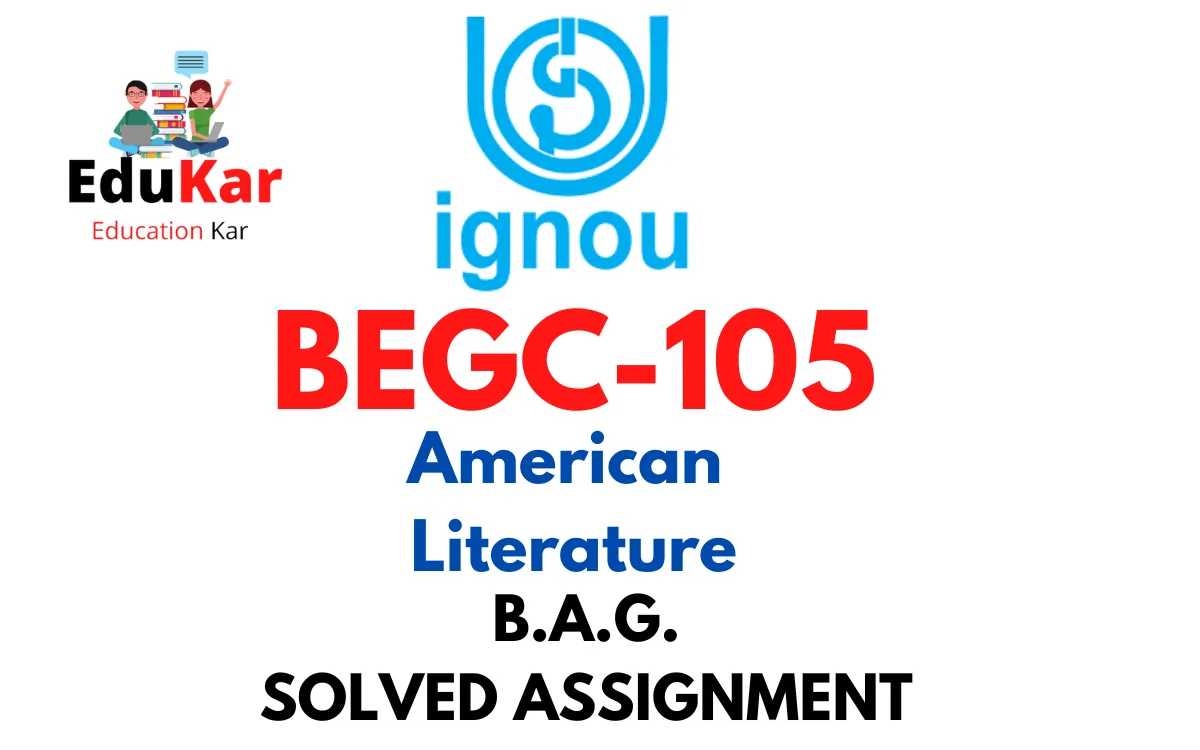
| Title | BEGC-105: IGNOU BAG Solved Assignment 2022-2023 |
| University | IGNOU |
| Degree | Bachelor Degree Programme |
| Course Code | BEGC-105 |
| Course Name | American Literature |
| Programme Name | Bachelor of Arts (General) |
| Programme Code | BAG |
| Total Marks | 100 |
| Year | 2022-2023 |
| Language | English |
| Assignment Code | TMA 01/2022-23 |
| Last Date for Submission of Assignment: | For June Examination: 31st April For December Examination: 30th September |


Section A
Answer with reference to the context:
1. (i) The white man, disguised
as a falcon, swoops in
and yet again steals a salmon
from Crow’s talon.
Ans: Without additional context, it is difficult to determine the specific meaning and significance of this statement. However, based on the given sentence, it appears to describe a scene in which a white man has disguised himself as a falcon and has successfully stolen a salmon from the talons of a crow.
It is possible that this statement is part of a larger narrative or story, in which the actions of the white man and the crow are significant in some way. The use of a falcon as a disguise may suggest that the white man is trying to conceal his identity, or that he is using his cunning or skill to catch the salmon.
Without further information, it is difficult to determine the exact context and meaning of this statement.
(ii) If the red slayer thinks he slays
Or if the slain thinks he is slain
They know not well the subtle ways
I keep, and pass, and turn again
Ans: The given lines appear to be part of a poem or a piece of writing that reflects on the nature of life and death, and the ways in which humans perceive and understand these concepts.
The first two lines suggest that both the “red slayer” and the “slain” may not fully understand the nature of death and killing. The third line emphasizes the “subtle ways” in which the author or narrator keeps, passes, and turns again, suggesting that there are complexities and nuances to the cycle of life and death that may not be fully grasped by those involved.
Overall, the lines suggest a certain ambiguity or uncertainty around the nature of life and death, and the ways in which humans understand and interpret these fundamental concepts. The use of language and imagery in the lines may also suggest a certain level of mysticism or spirituality, as well as a deep respect for the mysteries of the natural world.
(iii) But somewhere in my soul, I know
I have met the Thing before;
It just reminded me-‘t was alland came my way no more.
Ans: The given lines appear to be part of a poem or a piece of writing that reflects on the experience of encountering something that feels familiar or significant, even if it is difficult to explain or fully understand.
The first line suggests a sense of intuition or inner knowledge, as the narrator describes feeling that they have “met the Thing before.” This may refer to a person, an object, a place, or some other kind of experience that resonates with the narrator in a profound way.
The second line emphasizes the narrator’s recognition of the Thing, which may suggest that it has some kind of deeper meaning or significance for them. However, the third line suggests that the encounter was brief and fleeting, as the Thing “came my way no more.”
Overall, the lines convey a sense of mystery and ambiguity, as well as a deep emotional resonance. The narrator’s sense of recognition and familiarity with the Thing suggests that there is a deeper level of meaning or significance to the encounter, even if it is not fully understood or explained.
(iv) We slowly drove-he knew no haste
and I had put away
My labour and leisure too,
for his civility.
Ans: The given lines appear to be part of a poem or a piece of writing that reflects on a leisurely drive or journey taken with another person, possibly a companion or a stranger.
The first line suggests that the pace of the journey is slow and deliberate, as the narrator notes that “he knew no haste.” This may suggest a sense of relaxation or a lack of urgency, as the two individuals take their time and enjoy the journey.
The second line, “and I had put away / My labour and leisure too,” suggests that the narrator has set aside their own responsibilities and concerns in order to enjoy the journey with the other person. This may suggest a sense of mutual respect and civility between the two, as well as a willingness to set aside individual interests in order to connect with another person.
Overall, the lines convey a sense of peace and serenity, as well as a connection between the two individuals on the journey. The focus on “civility” suggests a certain level of politeness and respect, which may be a reflection of the values and attitudes of the time period in which the poem was written.
Section B
Answer the following in about 300 words each:
1. Write an extended note on the poetic devices used in ‘Passage to India’.
Ans: “Passage to India” is a novel by E.M. Forster published in 1924. The book explores the complex relationship between the British colonial rulers and the native Indian population during the early 20th century. The novel is written in a highly poetic style and employs a range of literary devices to convey its themes and ideas. Here are some of the poetic devices used in “Passage to India”.
- Symbolism – Forster uses a range of symbols to convey his ideas. For example, the Marabar Caves are used as a symbol of the mysterious and ultimately unknowable nature of India. The caves are also a symbol of the sense of disorientation and confusion experienced by the British characters as they try to understand the country and its people.
- Imagery – Forster uses vivid imagery to create a sense of place and atmosphere. He describes the Indian landscape in rich detail, using metaphors and similes to bring it to life. The descriptions of the heat, the dust, and the smells of India all contribute to the novel’s sense of sensory overload.
- Allusion – Forster makes use of literary allusions to convey his themes. For example, the character of Mrs. Moore is named after the poet Thomas Moore, who wrote extensively about the East. This allusion emphasizes the character’s sense of connection to India and her sympathy with its people.
- Irony – Forster employs irony throughout the novel to highlight the absurdity of the British colonial project. The characters’ attempts to understand and control India are repeatedly shown to be misguided and doomed to failure.
- Repetition – Forster uses repetition to emphasize key themes and ideas. The phrase “only connect” is repeated throughout the novel and serves as a reminder of the importance of human connection and understanding.
Overall, the poetic devices used in “Passage to India” serve to create a rich and immersive reading experience that brings the world of colonial India to life. The use of symbols, imagery, allusion, irony, and repetition all contribute to the novel’s themes of cultural conflict and human connection.
However, it should be noted that the use of poetic devices can also create a sense of distance between the reader and the characters. Some critics have argued that the highly stylized nature of Forster’s writing can make it difficult to engage with the novel’s themes on a deeper level. Nonetheless, “Passage to India” remains a significant work of 20th-century literature and a powerful exploration of the cultural complexities of colonialism.
2. How does Howthorne present the organic-mechanical contrast in the novel The Scarlet Letter?
Ans: In “The Scarlet Letter,” Nathaniel Hawthorne presents a contrast between the organic and the mechanical to explore the tension between nature and society. This tension is embodied in the characters of Hester Prynne, Arthur Dimmesdale, and Roger Chillingworth.
Hester Prynne represents the organic, natural world. She is associated with the natural beauty of the forest and the wilderness. Her sin, the product of a natural, passionate relationship with Arthur Dimmesdale, is seen as a rebellion against the strictures of society. Hester’s punishment, the scarlet letter A, is a symbol of her rejection by society, but it also becomes a symbol of her connection to the natural world. The letter itself is embroidered with wildflowers, and Hester is often depicted surrounded by the beauty of the forest.
In contrast, Arthur Dimmesdale and Roger Chillingworth represent the mechanical, societal world. Dimmesdale, as a minister, represents the strictures of Puritan society and the power of the Church. He is tormented by his secret sin and the fear of discovery, which puts him in a state of constant tension. Chillingworth, as a physician, represents the scientific and medical knowledge that is used to control and regulate the human body. He is described as having a “mechanical” demeanor and is obsessed with using his knowledge to uncover Dimmesdale’s guilt.
Throughout the novel, Hawthorne highlights the tension between the organic and the mechanical. The natural world, represented by Hester, is seen as a force of vitality and life, while the mechanical world, represented by Dimmesdale and Chillingworth, is seen as a force of repression and control. Hester’s relationship with Dimmesdale is depicted as a natural, spontaneous union that is disrupted by the mechanical forces of society. The contrast between the two worlds highlights the central tension of the novel, which is the conflict between the individual and society.
3. Write a critical appreciation of the poem “O Captain! My Captain!”.
Ans: “O Captain! My Captain!” is a poem by Walt Whitman, written in 1865 as an elegy for President Abraham Lincoln, who had recently been assassinated. The poem is a poignant tribute to the fallen president and a powerful expression of grief and loss. The poem has become one of Whitman’s most famous works, and its popularity has endured to the present day. Here is a critical appreciation of the poem.
The poem is structured as an extended metaphor, with the captain of a ship representing Lincoln and the ship itself representing the United States. The poem begins with a call to attention, as the speaker urges the captain to rise and receive the accolades of the crowd. The use of the imperative voice here creates a sense of urgency and immediacy, as if the captain’s life and legacy are hanging in the balance.
The central theme of the poem is the contrast between triumph and tragedy. The first two stanzas describe the jubilation and excitement of the crowd as the ship returns home after a long and perilous journey. The third stanza, however, reveals the tragic news of the captain’s death, and the mood of the poem shifts from celebration to mourning. The contrast between these two moods creates a powerful sense of emotional intensity and highlights the magnitude of the loss.
Whitman employs a range of poetic devices to convey his message. The use of repetition in the phrase “O Captain! My Captain!” creates a sense of rhythm and momentum, while the use of apostrophe gives the poem a deeply personal and emotional tone. The use of metaphor, as noted earlier, is central to the poem’s structure and theme.
The poem’s imagery is also highly evocative, with the ship representing the United States and the sea representing the tumultuous forces of history. The use of the word “fearful” in the second stanza creates a sense of danger and uncertainty, while the image of the ship “weather’d every rack” creates a sense of resilience and determination.
4. How did Henrik Ibsen contribute to the growth of modern American
Drama?
Ans: Henrik Ibsen was a Norwegian playwright who is widely regarded as one of the most influential figures in the development of modern drama. His plays, which often dealt with issues of morality and social critique, had a profound impact on American theater, both in terms of style and subject matter. In this response, we will explore some of the ways in which Ibsen contributed to the growth of modern American drama.
One of Ibsen’s most significant contributions was the development of the realistic drama. His plays were characterized by their naturalistic style, with realistic settings, dialogue, and characters that reflected the complexities and contradictions of real life. This approach was a departure from the melodramatic and stylized plays that were popular in the 19th century, and it had a profound impact on American playwrights of the early 20th century.
Ibsen’s plays also dealt with controversial social issues, such as gender relations, political corruption, and the role of the individual in society. He was a master of the social critique, and his plays challenged the conventions of his time in ways that were both shocking and thought-provoking. This influence can be seen in the works of American playwrights such as Eugene O’Neill, Arthur Miller, and Tennessee Williams, who often tackled similar issues in their own plays.
In addition to his contributions to style and subject matter, Ibsen also had a significant impact on the development of modern theater as an institution. His plays were often controversial and sparked heated debates, which helped to raise the profile of theater as an important cultural form. Ibsen’s success as a playwright also helped to establish the idea of the “auteur” playwright, who was able to exert creative control over every aspect of a production.
How to Download BEGC-105 Solved Assignment?
You can download it from the www.edukar.in, they have a big database for all the IGNOU solved assignments.
Is the BEGC-105 Solved Assignment Free?
Yes this is absolutely free to download the solved assignment from www.edukar.in
What is the last submission date for BEGC-105 Solved Assignment?
For June Examination: 31st April, For December Examination: 30th October
